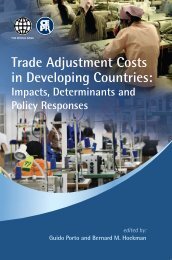What G20 Leaders Must Do To Stabilise our Economy and Fix ... - Vox
What G20 Leaders Must Do To Stabilise our Economy and Fix ... - Vox
What G20 Leaders Must Do To Stabilise our Economy and Fix ... - Vox
Create successful ePaper yourself
Turn your PDF publications into a flip-book with our unique Google optimized e-Paper software.
A New Bretton Woods system should curbboom <strong>and</strong> bustVijay Joshi <strong>and</strong> David VinesOxford University; Oxford University <strong>and</strong> CEPR<strong>To</strong>day's crisis has roots in a risky international monetary system as well as a risky financialsystem. Current international monetary arrangements enc<strong>our</strong>age boom <strong>and</strong> bust cycles. <strong>G20</strong>leaders should aim to build a system that induces nations to manage their macroeconomiesin ways that produce neither financial bubbles nor large external imbalances <strong>and</strong> inappropriateexchange rates.While some <strong>G20</strong> leaders hope the November 15th Summit will lay the foundationsfor a 'New Bretton Woods', many are sceptical <strong>and</strong> we share this view. The 1944Bretton Woods Conference was preceded by three years of difficult discussions amongthe US, UK, <strong>and</strong> other nations.The <strong>G20</strong> leaders should start a process that will eventually produce agreement afterthe present crisis has subsided. At this meeting, they should lay out the essential elementsof a new system. We argue that better financial regulation is only one of theseelements.The rollercoaster ride that the world economy has been on this decade has revealeda sc<strong>and</strong>alously risky financial system. It has also revealed a risky international monetarysystem that enc<strong>our</strong>aged boom <strong>and</strong> bust cycles. If the <strong>G20</strong> leaders aim to build a'New Bretton Woods' system, they will have to address more than financial regulation.Since current international monetary arrangements tend to fuel instability, thenew system must also address monetary arrangements.A boom-<strong>and</strong>-bust international monetary systemAn important feature of the rollercoaster ride was excess savings, especially in EastAsia. For example, in Indonesia, Korea <strong>and</strong> Thail<strong>and</strong>, investment fell by 10% of GDPafter the Asian financial crisis, <strong>and</strong> has stayed down. China's savings outstripped itsalready very high investments. The excess savings were translated into currentaccount surpluses since sterilized foreign exchange intervention kept exchange ratesundervalued. All this made sense for the individual nations. It allowed them to accumulatereserves as insurance against a 1997-style crisis <strong>and</strong> it fostered export-ledindustrialisation.Asian excess savings were greeted by American cheap-money policies. US interestrates were cut from 6% to 1¾% in 2001, then cut further to 1% <strong>and</strong> remained exceptionallylow for three years. The result was colossal housing <strong>and</strong> asset price bubbles,<strong>and</strong> very large current account imbalances, with the dollar's reserve-currency statusaiding <strong>and</strong> abetting America's ability to run massive trade deficits. All this made sensefor the US. The US interest rate policy was an underst<strong>and</strong>able, even necessary,response to prevent Asian excess savings <strong>and</strong> current account surpluses from causinga recession in the US <strong>and</strong> the rest of the world.57














